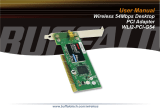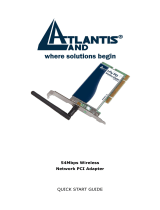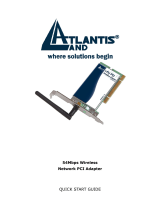Page is loading ...

User Manual
Wireless 54Mbps
Notebook Adapter
WLI-CB-G54L
www.buffalotech.com/wireless

2
Introduction
802.11g Wireless 54Mbps Notebook Adapter
Windows XP – Installation & Confi guration
1. Installing the Wireless 54Mbps Notebook Adapter Drivers:
◗ Insert the AirNavigator CD
into the CD-ROM drive of the
PC. The Air Navigator Setup
Wizard launches automatically.
If the Air Navigator Setup Wiz-
ard does not launch automati-
cally, launch the wizard manu-
ally by selecting Start>>Run to
open the Run dialog box. Enter
D:\Setup.exe in the Open fi eld.
D: represents the letter as-
signed to the CD-ROM drive. If
another letter is assigned to the
CD-ROM drive, your command
should refelect that difference.
Click the OK button to launch
the wizard.

3
◗ Select Install Wireles
Adapter. Click the OK button
to begin the installation pro-
cess.
◗ Review the Software License
Agreement. Click the Yes but-
ton to confi rm your agreement
with the terms and continue
installing the Wireless PCI
Adapter drivers. Click the No
button to abort the installation
process.
Introduction

4
Introduction
2. Installing the Wireless 54Mbps Notebook Adapter:
◗ Power on the notebook PC and let it boot into Windows. Firmly insert the Wireless Notebook
Adapter into an available CardBus slot. CardBus slots are located on one side of the notebook.
Please consult the Notebook Manufacturer's documentation for CardBus installation instruc-
tions. Once the Wireless Notebook Adapter is installed correctly, then the Found New Hardware
Wizard will launch automatically. If the Found New Hardware Wizard does not launch, turn off
the computer, remove the Wireless Notebook Adapter, restart the Notebook, and reinsert the
Wireless Notebook Adapter after Windows has restarted.
◗ Select Install the software automatically. Click the Next button.

5
Introduction
◗ Select the driver you want to install. If multiple drivers are listed, select the most recent driver
version. Click the Next button.
◗ If a window opens, stating that your driver does not pass Windows Logo testing, click the
Continue Anyway button. When the Wireless 54Mbps Notebook Adapter is successfully in-
stalled,
click the Finish button. Restart your PC if prompted.

6
3. Confi guring Wireless Zero Confi guration
Service:
◗ If the Wireless Zero Confi guration Service is activated,
Windows will scan for available wireless access points
once the Wireless PCI Adapter is properly installed. If
Windows detects one or more access points, a network-
ing icon appears on the task bar. One or more wireless
networks are available appears as a caption accompany-
ing the icon.
■ Note: If the Wireless Zero Confi guration Service is not
functioning, select Start>Control Panel>Administrative
Tools>Services. Select Automatic in the Startup Type
fi eld of Wireless Zero Confi guration Service to enable the
Wireless Zero Confi guration Service. The default value of
Wireless Zero Confi guration Service is Automatic.
◗ Right click the networking icon in the taskbar and se-
lect View Available Wireless Networks to display a list
of available wireless networks. Select an access point
network name or SSID and click the Connect button to
establish a connection. You may need to check the box
indicating you are connecting to an unsecured network.
See Page 7 if you need to enter an SSID network name
or WEP/WPA encryption key.
Introduction

7
◗ Click the Advanced button to enter an SSID network name or WEP/WPA encryption key, if
either is necessary. To add an SSID network name that is not available, click the Add button.
Introduction

8
Introduction
◗ To confi gure a WEP/WPA encryption key, select the ap-
propriate wireless network and click the Confi gure button.
◗ From the pull down menu, select the appropriate Net-
work Authentication and Data Encryption for the wireless
network. Enter and confi rm the Network Key and Key
Index. Click the OK button when fi nished.
■ Note: Buffalo Technology recommends that users of the
Wireless Zero Confi guration Service upgrade to the latest
version freely available at: http://www.microsoft.com.
For advanced support in using Window’s XP’s Wireless
Zero Confi guration Service, refer to the Buffalo Support Web
Site: http://www.buffalotech.com/wireless/support
Skip to Page 12 if you are not using Windows XP or prefer
not to use Windows XP's Wireless Zero Configuration
Service.

9
Installation / Setup
Windows 98/ME/2000
Installation & Confi guration
1. Installing the Wireless 54Mbps Notebook Adapter:
◗ Power on the notebook PC and let it boot into Windows. Firmly insert the Wireless Notebook
Adapter into an available CardBus slot. CardBus slots are located on one side of the notebook.
Please consult the Notebook Manufacturer's documentation for CardBus installation instructions.
Once the Wireless Notebook Adapter is installed correctly, then the Found New Hardware
Wizard will launch automatically. If the Found New Hardware Wizard does not launch, turn off
the computer, remove the Wireless Notebook Adapter, restart the Notebook, and reinsert the
Wireless Notebook Adapter after Windows has restarted.

10
Installation / Setup
2. Installing the Wireless 54Mbps Notebook Adapter-Drivers:
◗
Insert the AirNavigator CD. Click Next at the Welcome to the Found New Hardware Wizard.
Select Search for a suitable driver for my device. Click the Next button to continue.
◗ Select only the CD-ROM drives checkbox, and clear any other checkboxes that are selected.
Click the Next button to continue.

11
Installation / Setup
◗ Windows will display a driver you can use with the Wireless Desktop PCI Adapter.
Click the Next button to continue.
◗ Windows 2000: If the Digital Signature
Not Found page opens, informing that
no digital signature exists for the driver
you are installing, click the Yes button to
continue the installation process. When
the Wireless Desktop PCI Adapter is suc-
cessfully installed, click the Finish button.
Restart your computer if prompted.
See the Installing Client Manager section
to install the Client Manager.

12
Client Manager
Use Client Manager to confi gure your wireless network. Use Client Manager to survey and connect
to available access points, enable and use WEP encryption, and create connection profi les.
■ Note: Client Manager does not function properly if the Windows XP Wireless Zero Confi guration
Service is enabled.
Installing Client Manager
◗ Insert the AirNavigator CD. The
AirNavigator dialog box will open automati-
cally. If the AirNavigator dialog box does not
open automatically, select Start»Run and enter
D:\Setup.exe in the Open fi eld to open the
dialog box manually. D: represents the letter as-
signed to the CD-ROM drive. If another letter is
assigned to the CD-ROM drive, your command
should refl ect that difference. Click the OK but-
ton. Select Install Client Manager to launch the
InstallShieldWizard.
◗ Once the InstallShield Wizard launches, click
the Next button to begin the software installa-
tion.
Client Manager

13
Client Manager
◗ Once the Installer Wizard launches, click the Next button to begin the software installation.
◗ Press I Agree to accept the license agreement and continue the installation process.

14
Client Manager
◗ Press the OK button to fi nish and close the
installation program.
◗ Press the Exit button to exit the Client
Manager installation utility.
◗ The Buffalo Client Manager is now installed
and running, right clicking on its icon (the black
notebook icon) will allow you to begin using it.

15
Client Manager Confi guration
Use Client Manager to confi gure your wireless network. To assist in confi guring your wireless
network, Client Manager consists of the Status page, the Survey page, and the Profi les page. You
can access each page by clicking the corresponding button on Client Manager. In addition to these
pages, several dialog boxes are available to meet specialized confi guration needs. You can access
the Edit Profi le dialog box, New Profi le dialog box, IP Confi guration dialog box, or WEP Confi gura-
tion dialog box using the Client Manager pages.
Status Page
Click the Status button to open this page. By
default, this page is displayed when you start
Client Manager. This page displays the status
of the connection between the wireless
adapter and another wireless device. This
page only displays connection information no
changes to the connection can be made from
this screen.
This page includes the following components:
• Network Type – Displays what mode the
network device is in. Ad-Hoc or Infrastructure
are the available modes.
Client Manager Confi guration

16
Client Manager Confi guration
• Rate – The speed that the two wireless clients are communicating at. If the Client Manager is
not connected to a remote wireless device (access point or another client) then no rate will be
displayed.
• Channel – The channel that the two wireless clients are communicating at. If the Client Manager
is not connected to a remote wireless device (access point of another client) then no channel will
be displayed. The available channels for use are 1-11.
• Security– The type of encryption that the two wireless clients are communicating with. If the
Client Manager is not connected to a remote wireless device (access point of another client) then
‘No Encryption’ will be displayed.
• IP Address – The IP address of the machine the Client Manager is installed on. If the Client
Manager is not connected to a remote wireless device (access point of another client) or is not
connected to a network with DHCP, then no IP address will be displayed.
• MAC Address – The MAC address of the wireless client device inside the computer Client Man-
ager is installed on. If no wireless device is present in the computer, then no MAC Address will be
displayed.
• Signal Strength – Displays the strength of the signal. Signal Strength is based on the peak signal
level the wireless adapter receives from the wireless device to which it is connected. Next to the
signal level is the wireless hardware type that the computer has available.

17
Client Manager Confi guration
Survey Page
Click the Survey button to open this page. Use this page to survey the area, display available ac-
cess points, and connect to available access points.
This page includes the following components:
• Wireless SSID – Displays the SSID associ-
ated with each available access point. The
SSID is the unique network name that func-
tions as an identifi er for your wireless devices.
All wireless devices on a network must use
identical SSIDs to successfully associate with
other devices on the network. buffalo_test is
an example of a valid SSID.
• Mode – Displays the mode/rate set that the
remote wireless device is offering.
• Key – Displays whether the wireless net-
work is using any sort of encryption.
Press the ‘Connect’ button to connect to a listed SSID, or press the ‘Refresh’ button to perform
another survey and update the survey list.

18
Client Manager Confi guration
Once the ‘Connect’ button is pressed, you will be prompted to enter any encryption related infor-
mation.
The ‘Acquire IP automatically’ checkbox tells the cli-
ent device to obtain an IP automatically from a DHCP
server. This is the recommended setting.
The ‘Encryption’ drop down list allows you to select
the type of encryption for the network. By default the
proper encryption type should already be selected.
In the event that no encryption is used, leave the ‘No
Encryption’ option selected.
The ‘Encryption Key’ is where the actual key required
by the wireless network must be inputted. Please consult your wireless access point or router’s
documentation for proper input of the encryption keys. Some wireless networks may require you to
enter multiple keys, in this event, four separate fi elds are available for encryption keys.
The ‘Save settings as a profi le’ option will store this wireless network in your profi les. This means
you will automatically connect to this network when inside its range. This settings is recommended
if you plan on using this wireless network more than once.

19
Profi les Page
Click the Profi les button to open this page.
Use this page to access your profi les. Profi les
allow you to save the information associated
with a specifi c wireless network so you can
quickly and easily connect to that network
when you are in that location. The Profi les
page allows you to add, delete, and edit your
profi les, as well as import and export data.
• Connect – Click the Connect button to con-
nect to the selected profi le and return to the
‘Status’ page.
• Edit – Click the Edit button to edit the se-
lected profi le’s settings. The Edit button also
allows you to delete a profi le no longer used or required.
• Add – Click the Add button to add a profi le manually. You will need important information such
as SSID, encryption settings, and network type.
Client Manager Confi guration

20
New Profi le Dialog Box
Use this dialog box to create a new profi le.
Client Manager Confi guration
• Profi le Name – Enter the name you want to associate with the
new profi le.
• Network Type – Select the network mode you want to associ-
ate with the new profi le. Select Infrastructure if your network
consists of both wired and wireless devices that communicate
through a central device, such as an access point. Select
Ad-hoc if your network consists of only wireless devices that
communicate with each other directly.
• Network Name SSID – Enter the SSID of your network. The
SSID is the unique network name that functions an identifi er
for your wireless devices. All wireless devices on a network
must use identical SSIDs to successfully associate with other devices on the network. myssid is
an example of a valid SSID.
• Channel – Displays the channel associated with the new profi le. The channel indicates what
range of frequencies the radio waves emitted by the wireless device are occupying. Devices that
meet 802.11b and 802.11g standards can use channels 1-11 within the 2.4 GHz spectrum.
• Encryption Type – Displays the types of encryptions available. Once selected, you will be
required to enter the Encryption Key Number and the Encryption Key as well. For the Encryp-
tion Key Number, it is recommended to use 1 unless specifi ed to by an administrator.
• OK – Click the OK button to save your specifi cations and return to the Profi les page.
/











